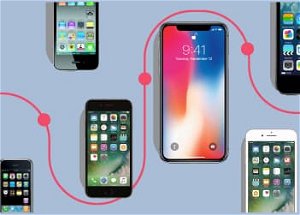
If you’re like us, there are few things scarier than the sight of your phone facedown on the pavement.
No one wants to fork out hundreds of dollars unexpectedly. But it’s not just the thought of replacement costs that are scary.
It’s the thought of not having access to our mobile office, entertainment hub, fitness tracker, photo albums or scheduling tools.
Today’s phones are more than simply communication tools.
They’re a part of daily life. And things get weird without them.
So it makes sense that you’d want to ensure that your phone is protected should the unexpected happen.
For many people, this means picking up phone insurance. But is this really the best way to protect your phone?
Well, we’ve researched the issue. And it turns out that while insurance offers protection, it’s not always the deal that many companies make it out to be.
We'll share what we've discovered, starting with the basics of how phone insurance works and highlighting the pros and cons. From there, we’ll offer alternative suggestions that might help you save money while still keeping your phone safe.
Let’s get started!
Editor’s Note: This post has been updated for 2022.
In this in-depth guide, we’ll explain:
How Does Phone Insurance Work?
Phone insurance is just like any other type of insurance you’d purchase.
You buy a plan—either by way of monthly subscriptions or an upfront payment at the time of purchase. Should something happen to your phone, you’ll receive compensation after paying your deductible.
Most phone insurance options fall into one of four categories:
1. Carrier-Based Insurance
You’ve probably seen these plans lurking around on your carrier’s add-ons page. You pay an additional fee each month for each device you want covered. When you need to make a claim, you contact your carrier, pay a deductible and they ship a replacement phone. Some also allow swapping your damaged phone at a carrier store.
2. Third-Party Subscriptions
These options are newer but gaining popularity. They work much like a carrier-based subscription, only you’re paying a different company. Costs are billed separately, so you’ll have one more bill to keep track of. However, most offer extra perks you won’t find with carriers.
The biggest limitation to these plans is purchase requirements. Some companies, such as Geek Squad, only cover devices purchased at their store and you can only sign up for protection coverage within a certain period -- often 30 to 90 days -- of the original purchase.
Popular options include:
3. Third-Party Protection Plans
These differ slightly from insurance plans as you pay for them upfront within a short time of purchasing your new phone. They often add to the manufacturer’s warranty—both in what they cover and how long you’re protected. However, unlike insurance, once your plan ends, you might not be able to renew it.
Deductibles—the fees you must pay if you make a claim—vary between companies. But in most cases, deductibles are lower than insurance plans.
Unfortunately, coverage is lower too. Many protection plans won’t cover loss or theft.
Depending on the company, protection plans might transfer with ownership of the phone. If you usually sell your phone at upgrade time, this can add to your asking price.
Popular options include:
4. Manufacturer Protection Plans
Some manufacturers also sell protection plans. In most cases, if your manufacturer offers a plan, it’s probably one of the best deals you’ll find.
Current options include:
- Apple’s AppleCare+
- Samsung’s Premium Care
- Motorola’s Moto Care
- Google’s Preferred Care
What’s Covered by Mobile Phone Insurance
Coverage varies by provider. Some even offer multiple tiers of coverage. So, it’s important to dig into the details of any plan you’re considering before you sign up.
In most cases, phone insurance covers:
- Manufacturing Defects: Should something go wrong that isn’t your fault but isn’t covered by the manufacturer warranty, your insurance plan will fill the gap.
- Battery Replacement: As a phone’s battery goes through charging cycles, it slowly loses the ability to hold a charge. Many warranties will replace a battery upon request if it’s no longer holding a charge.
- Loss or Theft: Should you misplace your phone, or someone swipes it, you can pay your deductible and receive a replacement.
Other protections you might find include:
- Accidental Damage Protection: If your phone slips off the table or you drop it on the sidewalk, you’re still covered! Did your dog run through and snag a cable and now your headphone jack or charging port doesn’t work? They’ll fix it!
- Water Damage Protection: Some plans treat water damage differently. In fact, a lot of plans don’t cover it at all. But there are some plans that do—such as Squaretrade. With water damage protection, there’s no need to fear accidental dips in the pool or runs through the wash.
- New Phone Setup: Some insurance plans will help you to get your data and settings from your old phone your new one. While most smartphones store most of your information online anyhow, these services add peace of mind and reduce hassle.
- Specialized Support: Should you have a question about a feature on your phone or how to set up apps, some insurance plans feature dedicated support lines without the hold times of standard customer support options.
NOTE: Many insurance plans have exemptions for blatant abuse or negligence. An insurance plan doesn’t give you a reason to throw your phone out the window or intentionally take it for a swim. If you do, you might find that your claim is denied.
So I Just Make a Claim and They Send Me a Brand New Phone?
Again, this will vary by provider. But in most cases, the answer is no.
With many insurance providers, once you make a claim, you’ll need to mail your device to a service center or drop it off at a retail location.
Then one of three things happens:
- If they can fix the phone, they’ll fix it and send it back. Service usually takes between 3 to 10 business days.
- If they cannot fix the phone, you’re issued a replacement. In most cases, this is a refurbished device. Service is typically a little quicker and some providers will even ship out a replacement before receiving your device.
- If they cannot fix the phone and it’s no longer in stock, you might receive a completely different model they deem to be of equal value. You can read about the perils of this over at PC Gamer.
Long story short, unless they can fix your phone, this outcome probably isn’t as good as you’d hoped.
With some third-party protection plans, you might receive a payout instead of replacement.
In this case, you’ll send the device to the service provider and they’ll mail you a check for the value of the phone. You can then purchase a replacement at your own discretion.
If you purchased your insurance or protection plan through a retailer, you might be able to bring your broken device to a retail location for immediate exchange.
This saves the cost and hassles of shipping and can have you back up and running the same day. However, in most cases, the plans you purchase from retailers such as Best Buy or Costco are more expensive.
NOTE: Some insurance and protection plans do not cover issues during travel. If you’re planning to explore the world, be sure to check if you’re covered before taking off. You might be better off picking up a cheap prepaid phone and leaving your main phone at home. You’ll likely pay cheaper rates at your destination to use your phone with a prepaid or travel SIM, and if it breaks or is stolen, you’re not losing hundreds of dollars.
I Already Have Homeowner’s or Renter’s Insurance. Can I Use That Instead?
In some cases, yes. However, you should contact your insurance provider before counting on this option. Some will require an addition or “rider” on your policy to cover the phone.
Even if they agree to cover your phone, it might not be worth it. While phones are expensive and, for many, an essential tool, the cost of a new phone is likely less than the increased premium you’ll pay for months or years after a claim.
However, one situation where this might work is a major loss, such as a fire, flood or if someone steals your phone, laptop and camera. Even if each item was insured separately with protection plans, individual deductibles could pile up fast. Paying more for your insurance for a while but only having one deductible might end up cheaper in the big picture.
What About the Manufacturer’s Warranty?
Manufacturer’s warranties are great but only cover defects. This means if you drop your phone or lose it, your warranty won’t help. However, if your phone isn’t working through no fault of your own, it might be an option to try.
Most will require you to ship the device back to them—sometimes at your cost—and they’ll either repair or replace it. This is better than insurance in the sense that you’ll likely get your exact phone back or a replacement of the same model. But it might take a week or two to get back up and running between repair times and shipping.
How Much Does Phone Insurance Cost?
Insurance prices vary depending on the company you choose and the type of device you need to insure. For example, some companies charge more for a plan or increase deductibles for flagship phones or other high-end devices.
At the time of writing, insurance plan pricing for the major carriers are as follows:
- AT&T: $8.99 to $15.00 per month with discounts on multi-line accounts for up to 4 devices.
- Verizon: $12 to $15 per month with discounts on multi-line accounts.
- T-Mobile: $7 to $18 per month
Most third-party subscription plans are comparably priced between $10 and $20 per month.
Protection plans, on the other hand, depend on the price of your device. As an example, Worth Avenue Group offers $1049 worth of coverage with a $75 deductible for $202. Unfortunately, many protection plans don’t cover theft or loss of your phone.
But remember, plan costs are only one part of the picture. If you need to make a claim, the insurance company will ask for a deductible as well.
As with monthly or upfront fees, deductibles often vary depending on the value of the phone.
Deductibles for major carriers at the time of writing are as follows:
- AT&T: $25 to $299 per claim depending on the value of the phone and date of your last claim
- Verizon: $49 to $249 per claim depending on the value of the phone
- T-Mobile: $10 to $249 per claim depending on the value of the phone
In most cases, unless you’re using a very basic phone, you can expect deductibles to be near the higher end of these scales.
Many of the subscription-based services and protection plans have deductibles between $49 and $99.
As you can see, even with insurance, replacing your phone still won’t be free. In some cases, after deductibles, you might even pay more for your replacement than picking up a used one online.
So Is Phone Insurance Really Worth It?
In the end, the answer depends on your situation. Let’s look at a few possible scenarios:
Scenario 1
You own the latest phone from Apple or Samsung. This puts you in the highest tier for deductibles on an insurance plan, but you want to protect your device—especially with its $1000 price tag.
You sign up for insurance and at month 8 disaster strikes. You’ve already paid $120 in monthly premiums. Now you need to pay a deductible of $249.
So your out-of-pocket replacement costs are $369—roughly 40% of the cost of buying a new phone retail.
Where the math gets tricky is refurbished replacements. For example, if a refurbished version of your new phone is selling for $525. Then your savings decrease.
This isn’t much of a concern with major brands, such as Samsung, Apple or LG, as their phones hold their value well. But if you’re using an expensive phone from a lesser-known manufacturer, you might find that buying a refurbished phone yourself is cheaper than the cost of monthly insurance payments and a deductible.
Is phone insurance worth it in this scenario? Verdict: 50/50
Scenario 2
You signed up for a contract and got a great deal through a phone subsidy or device leasing. You only paid $99 for the phone, but you must stick with the carrier for two years or face hefty fees. A $99 phone shouldn’t be too hard to replace, so you skip the insurance.
Six months later, you’re washing dishes and your phone slips off the counter and into the sink. You call up your carrier to see about another $99 phone only to find out that the replacement will be at full retail value--$549! Ending your contract early isn’t much cheaper.
So, unless you want to pick up a cheap phone that isn’t nearly as nice as what you had, you’re left spending a bunch of money to replace it, paying an expensive termination fee or paying for a line of service each month until the end of your contract but not being able to use it.
Is phone insurance worth it in this scenario? Verdict: Most likely (though avoiding subsidies and contracts is an even better option)
Scenario 3
You tend to buy whatever is affordable and will get the job done. In most cases, you’re unwilling to pay more than $300 for a phone. But you do like a capable smartphone. You jump for the insurance because it should save you money.
After 8 months, your son tries to flush your phone down the toilet. You’ve already paid $129 in monthly premiums and now you’re looking at a deductible of $199 because while your phone isn’t exactly new, it’s still a full-featured smartphone.
So your out-of-pocket replacement costs are $328. At this price, you could easily find a solid mid-tier phone using our comparison tool and have a new phone instead of a refurbished replacement.
Even if you don't mind a refurbished phone, there’s a good chance your it will be cheaper to buy it yourself than replace through your insurance. In this example, you’d have paid of retail for a device only worth 75% of retail at best.
To make matters worse, if your phone was older, there’s a good chance that your replacement won’t even be the same model of phone that you had before.
Is phone insurance worth it in this scenario? Verdict: Probably not
Scenario 4
You don’t want a fancy phone—just something reliable. So you find a deal for a $79 phone and grab it. You figure insurance is a simple way to save money replacing it if something goes wrong.
After 8 months, you leave your phone on the roof of the car as you pull out of the driveway. SMASH! You’ve already paid $80 in monthly premiums. They still want a $49 deductible. So, your out-of-pocket costs are $129—roughly 63% more than just popping by the store to pick up another cheap phone. To make matters worse, you paid a $49 deductible on a phone you can buy new at the local megamart for $50.
Is phone insurance worth it in this scenario? Verdict: NO
As you can see, insurance values vary—largely based on the price of your phone and how quickly you need to make a claim.
- If you’re always upgrading to the latest flagship, insurance probably offers a good value. Just don’t expect replacement to be free.
- Once you reach phone prices around $299, value you’ll get from insurance depends on how long you have insurance before you need to make a claim. But using the average figures from above, if you have insurance for more than 12 months, you could likely buy a new mid-tier handset for the price you’re paying for insurance and deductibles.
- For the budget tier, you’re not really saving any money on replacement after just a few months. You’re likely better off just replacing the phone if you break it instead of gambling on if you’ll beat the math on insurance.
Choosing the Best Phone Insurance for You
If you've decided you want cell phone insurance, the next question becomes: which insurance provider to choose?
The answer to this depends which smartphone you own.
For iPhones, Apple’s AppleCare+ is actually a pretty amazing deal. But you’re limited to two accidental damage repairs and you’ll still need to pay out of pocket. Still, $149 upfront with a $29 screen repair fee is still less than a year of insurance through carriers after deductibles.
Better still, if you have an Apple Store nearby, they can likely repair it on-site. This means you’ll be back up and running quickly.
For Samsung devices, Samsung’s Premium Care is likely the best option. Plan prices vary by device and deductibles are only $99.
For other Android and Windows phone, you’ll want to look at the section above and decide between an insurance plan or a protection plan.
If you’re worried about loss or theft, an insurance plan is probably a better option.
However, if you’re simply looking to replace a phone that’s been dropped or otherwise broken, a protection plan will likely save you some money.
Insurance Options Offered by Carriers Include:
| Carrier | Monthly Fee | Low Deductible | High Deductible | Total for 1 Claim after 24 Months |
|---|---|---|---|---|
 |
$8.99 - $15.00 | $25 | $299 | $241 - $659 |
 |
$12 - $15 | $49 | $249 | $337 - $609 |
 |
$7 - $18 | $10 | $249 | $178 - $681 |
Popular Protection Plans from Third-Parties and Manufacturers Include:
| Company | Cost | Deductible | Total with 1 Claim after 24 months |
|---|---|---|---|
| SquareTrade | $8.99 - $12.99 Per Month |
$25 - $149 | $241 - $460.76 |
| AppleCare+ | $149 - $299 One-Time Fee |
$29 - $269 | $178 - $568 |
| Samsung | $3.99 - $11.99 Per Month |
$99 - 249 | $195 - $537 |
| Motorola | $20 - $399 One-Time Fee |
$15 - $95 | $35 - $494 |
| $89 - $149 One-Time Fee on select devices | $24 - $149 | $113 - $298 |
Are There Any Alternative to Cell Phone Insurance or Protection Plans?
There’s a good chance that at some point, you’ll damage your phone—even if just cosmetically.
Without insurance, you might think that your only option is to buy a new phone. That’s not true.
These options might be able to get you back up and running cheaper than replacing your phone.
Just Pay Out of Pocket for Fixes If Required
Just because you don’t have insurance, doesn’t mean that the manufacturer or local electronic shop won’t repair your phone. You’ll just pay out of pocket for the fix. Also, if your phone is lost or stolen, you can’t repair something you can’t find.
In some cases, repairs are more affordable than you might think. For example, Apple will repair a cracked iPhone 11 screen for $199 even without coverage.
The best rates are often found at local phone or electronics shops. However, before you hand over your phone, see if they’re licensed by the manufacturer. If they’re not, repairs will void your warranty.
Then again, if your phone is broken, the warranty isn’t doing you much good either.
If you can’t find a shop nearby, search your local online classifieds or social media groups. You’ll often find someone offering mobile repair services.
See If Your Credit Card Company Provides Any Insurance
Some credit cards offer device protection although the exact terms vary by card. Some only extend manufacturer’s warranties while others add additional “purchase protection” or "device insurance" to help with damaged or stolen items.
However, most purchase protection options are only good for 90 to 120 days from the date of purchase. So you can’t count on this for long-term protection. They’ll also require you to make a claim through any insurance options you might have elsewhere before triggering your purchase protection.
Coverage amounts vary. If your card doesn’t include enough coverage for the full price of your phone, you might need to cover the difference out of pocket.
In most cases, you’ll start the claims process by calling your credit card provider instead of your carrier or the device manufacturer.
Roll Your Own Insurance Plan with a Secret Stash
Before you start setting money aside, it’s important to consider the two drawbacks to this plan:
- It requires planning and willpower.
- If something happens to your phone in the first few months, you’re probably not going to have much choice but to front replacement costs.
The concept is simple.
Take the price of your phone and divide it up into payments.
Instead of paying your carrier or a plan provider, put the money somewhere safe—and out of your main bank account—so you don’t spend it.
DON’T TOUCH IT
If your phone breaks, you should have savings built up to replace it.
If your phone doesn’t break, you can use your stash for your next upgrade and start again.
This is by far the most efficient option. You won’t pay any extra fees and you have the freedom to replace your device with anything you’d like if something goes wrong with your existing phone. In fact, if you keep the money in an interest-bearing savings account, you might even make a little money in the process!
For example, if you’re stashing money to replace an iPhone 11, the current price on Amazon for the 16GB unlocked model is $699. Divided into 12 payments, you’re looking at just over $58.25—skip a night or two out on the town or a family dinner at your favorite restaurant each month and you're good to go.
Even if you only made it to the 6 month mark before disaster strikes, you’ll have saved up $349.50. You won’t have a deductible to pay, so that leaves you adding $349.50 to your stash to buy the replacement. That's not far from the $229+ most services are asking for smartphone deductibles on high-end phones.
You can also sell your broken phone or recycle it to add to your savings.
If your phone survives until upgrade time, you can sell your used phone after upgrading to jumpstart the savings toward a new replacement fund.
Get Techy with DIY Repairs
Phones are getting more complex—particularly with waterproofing methods—so you might think twice before doing a repair yourself.
Even if you feel comfortable repairing your phone, you might also run into issues finding parts.
We recommend checking iFixit’s database of phone repair tutorials before trying to fix any phone problems. They offer step-by-step guides and videos for a range of popular devices.
You’ll also find links to purchase parts and tools. While you’ll probably pay more at iFixit than eBay or another source, the dependability is likely worth the cost.
Be sure to research parts, tools and time requirements first. Sometimes, it’s cheaper to replace than repair.
Summary
The real value of insurance depends on your phone, usage habits and budget
Protection plans often offer better value than insurance plans
Saving money yourself instead of buying insurance requires more effort, but offers the most flexibility and savings.
Always check the fine print to see what’s covered. Consider deductibles, covered damages, loss or theft coverage.
Always check the fine print to see how they will compensate you for your device. Many plans use refurbished phones or even different models entirely.
Self repair isn’t as easy as it once was—you’re usually better off going to a repair shop but this might void your warranty
Please note: This article is based on our opinion and does not constitute financial advice. When considering purchasing financial products, you should always speak with an Independent Financial Adviser.
P.S. Found this article after your phone was already lost, stolen or broken? Our Used Phone Buying Guide can help you find a good deal on a reliable used phone instead of shelling out the money for a new one. You can use the savings to kick start your stash toward the next upgrade or replacement!








